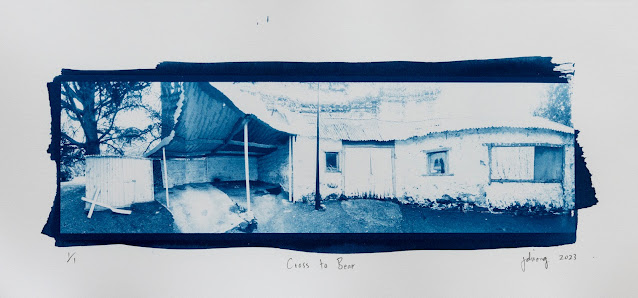Photography | Brian Rope
Under
the Sun & Cyscapes | Jane Duong
Reading
Room Gallery, Rusten House Art Centre | 4 February – 25 March 2023
Jane Duong is a Canberra-based photographer. She majored in photomedia at Edith Cowan University in 2003 for a Bachelor of Communications. Then, in 2007, graduated with a Diploma in Museums and Collections from the ANU.
As with her Sunkissed exhibition in 2022, Duong has used the cyanotype technique for this show. Under the Sun is more substantial - both in terms of the number of works and their content. Once again, the works do not shout seeking attention, but quietly encourage visitors in for a closer investigation. The cyanotype process dates back to the dawn of photography and was invented by astronomer Sir John Herschel in 1842. Prints are created with the use of a light-sensitive chemical mixture coated on paper, ultraviolet (or sun) light to expose, and water to wash before drying.
So, what are we looking at here? The
artworks result from an exploration and celebration of public spaces and
historical places in Queanbeyan - through the magic and coincidence that comes
with the cyanotype process. Her subjects include The Dog & Stile Inn, the
Queanbeyan River, Rusten and Benedict Houses, and the Ukrainian Greek-Catholic
Church. Each exhibited print is a one-off, handmade on cotton paper. Some have
unique borders. Some have been created with negative contact sheets. And some exposed
artworks were washed by dipping them directly into the Queanbeyan River.
 |
| Cross to bear - Jane Duong |
 |
| Rusten House I - Jane Duong |
When I learned to make prints from negatives in a darkroom years ago, it was drummed into me to use clean water for the processes. Nowadays, a growing number of artists seem to be using “unclean” water. Some collect water from creeks, dams, oceans or wherever to use. Others immerse the paper or other material on which they are printing directly into a water source, as Duong has done here for some works. In the last couple of days I have seen this approach questioned on social media, with someone wondering aloud whether it was appropriate to “contaminate” the ocean with cyanotype chemicals. Responses have been varied.

Dip your toe in the water - Jane Duong
Cyscapes is
a video work previously shown at a 2022 Contour 556 event, the Forest Bathing
Night Walk, put on by Localjinni Shinrin-Yoku in the Cork Forest at the National
Arboretum. Localjinni refers to itself as an eco-feminist art collective
which, traveling in collective safety at night, transforms spaces into places
using visual art, poetry, music, film, oral history, and digital stories.
The collective states that it ‘strides’ to bring local culture and active travel together, to reclaim community ownership of the street and public spaces. It asks that we think of the collective’s members as art street vendors. They screen virtual exhibitions, lighting up parks, paths, and plazas on night walks and scooter rides.
Their focus on place recognises the
importance of local production and local knowledge. As a Virtual Artist Run
Initiative (VARI), including more than fifty contributing artists and
artworkers, they bring research and teamwork together to develop and refine new
ways of connecting people to place. Checkout their website for more details: localjinni.com.au.
If, like me, you missed the Night Walk, you can view an interesting 2-minute showreel of it at https://www.youtube.com/watch?v=cTiKKhoH2J4.
The video on display in this gallery exhibition is described by the artist as “moving image, colour, sound, 2 minutes 46 seconds”. On a loop, viewers are able to watch the full video of moving images as many times as they wish. I watched them, mesmerised and enjoying windmills and foliage appearing on a tree.
.jpg) |
| Cyscapes-3 - Jane Duong (Still from video) |
.jpg) |
| Cyscapes-2 - Jane Duong (Still from video) |
Cyanotype images cleverly layered and manipulated with Duong’s choice of today’s software (which utilises Artificial Intelligence) created this most worthwhile video exhibit.
This review was first published in The Canberra Times on page 10 of Panorama and online here. It is also available on the author's blog here.